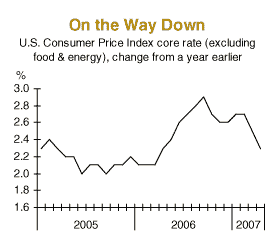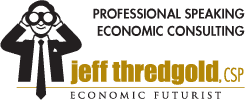|
May 23, 2007
EuroGrow
Written by Jeff Thredgold, CSP, President, Thredgold Economic Associates
The European economy continues to make subtle moves in the direction of more unified and impressive economic growth. Improving economic performance is tied, in part, to strong global economic growth. It is also tied to greater labor flexibility across the Continent than was the case a few years ago. The recent political shift to the right in France suggests that even the French economy might show more signs of growth in coming years than was the broad expectation a year ago.
European economic growth in 2006 was the strongest of the past six years. The more broadly defined 27-nation European Union recorded real (inflation adjusted) economic growth in 2006 of 3.0%. The 13 nations that share the euro currency saw real growth last year of 2.7%.
Growth forecasts for 2007 adopted by the European Commission—the executive arm of the European Union—see real growth near 2.9% for the larger Europe, with the euro currency nations seeing growth of 2.6%. In both cases, growth rates would likely exceed that found in the U.S.
Broad European unemployment was 7.2% in March 2007, the lowest in 14 years of recordkeeping. By comparison, U.S. unemployment is currently 4.5%.
European growth forecasts for 2008 are slightly weaker than expectations for this year. In contrast, most U.S. forecasts for 2008 see real growth returning to near 3.0%.
Various export-dependent European nations, particularly the Germans, are benefiting from strong global economic growth and rising demand for exports. While the stronger euro currency could, in theory, depress European exports, such a development has yet to occur.
Déjà Vu
By certain measures, the European economy is similar to where the U.S. economy was 2-3 years ago. Beginning in June 2004, the Federal Reserve—America’s central bank—began a lengthy process of monetary tightening in order to minimize inflation pressures tied to solid U.S. economic growth. Such a program is now underway in Europe.
The European Central Bank (ECB) has boosted its key short-term interest rate seven times since December 2005. The ECB announced recently that another 0.25% tightening move would occur in June, pushing the rate to 4.00%. In addition, the Bank of England…yes, that nation’s central bank…boosted its key rate to 5.50% recently, a six-year high. The Bank noted strong U.K. economic growth and high levels of business investment as its rationale.
Many economists see an additional move or two before the end of the year. In contrast, America’s key short-term interest rate has been at 5.25% since late June 2006 following 17 tightening moves, with many forecasters, including yours truly, seeing a chance for slight Fed ease late in 2007.
Labor Flexibility
So what are the Europeans finally doing right? Besides a boost from strong global growth, the Germans, the Spaniards, and others have introduced greater labor flexibility into their economies. As a result, various European companies are more willing to hire at home, versus shifting current jobs and new hiring to Eastern Europe.
The recent French election also bodes well for French economic competitiveness, although it will be a rocky road. The election of pro-America, pro-free market President Nicolas Sarkozy suggests the French are finally bending to the realities of 21st Century global competition.
Such was not the case over the past quarter century as French leadership saw the French “entitled” to do things their way. Double-digit unemployment and limited job opportunities for millions of young people of recent years finally got the electorate’s attention.

Cores
U.S. inflation pressures have moderated in recent months. This is a critical development regarding the Federal Reserve’s ability to possibly trim its key short-term interest rate later this year.
We still subscribe to the view that the next Fed move will be to reduce its federal funds rate from 5.25% to 5.00% late in the year, with a reasonable chance for a second 0.25% cut in 2008’s first quarter. The rate has been stuck at 5.25% for the past 11 months. 
Trust me…I recognize a statement about inflation moderation flies in the face of what you and I have paid at the gas pump and in the grocery store in recent weeks. However, the Fed’s most critical inflation measures have been more financial market friendly in recent weeks.
The “Core”
The Fed focuses much more on 12-month changes in inflation than on data of one- or two- or three-month periods. The Fed also focuses more on the “core” rate of inflation, which excludes volatile food and energy costs. However, another economist noted recently that the decline in the core rate of inflation was good news “only if you don’t use energy or eat food.”
…touché
Whether right or wrong, the Fed’s inflation attention is focused on the core personal consumption expenditures index (core PCE) and the core consumer price index (core CPI). Fed officials actually view the PCE inflation data as better consumer inflation data than the Consumer Price Index.
The “Target”
Current Federal Reserve Chair Ben Bernanke has spoken frequently in the past about his support of inflation targeting, i.e. establishing an official inflation target range within which the Fed tries to keep core inflation. Financial markets see this as an annual target range of 1.0%-2.0%. Such inflation targeting is commonplace in Europe, where the European Central Bank is firmly committed to the same 1.0%-2.0% range.
While Fed Chair Bernanke has not formally adopted inflation targeting at the Fed, financial markets nevertheless hold his feet to the fire as if he had. In contrast, former Fed Chair Alan Greenspan did not favor inflation targeting, but preferred to largely determine monetary policy by the seat of his pants.
As noted, the two 12-month (known as year-over-year) core inflation measures have been more favorable in recent months. The core PCE’s most recent 12-month rise was down to 2.1%, within striking distance of the unofficial range. In contrast, this inflation measure moved toward 3.0% over the prior 12 months. The core CPI has also behaved better, with the most recent 12-month rise down to 2.3%, versus more worrisome core inflation increases over the past 12-15 months.
Downshift
The American economy has slowed over the past year, no question. The 2.1% real (inflation adjusted) annual growth pace of the past 12 months is down more than 40% versus the healthy 3.7% real annual growth pace of the prior 12 months.
Such sluggishness is comparable to a car slowing from 55mph to a 31mph pace. Recent economic slowing should help minimize inflation pressures further in coming quarters. We expect these pressures to remain under control even as we see the economy picking up speed over the next four quarters.
Email this article to a friend
|
|
Subscribe to the Tea Leaf
Like what you just read? Have Jeff Thredgold’s Tea Leaf emailed to you free each week. Subscribe today.
|
|
|

“Tea”ser
Men are from Earth. Women are from Earth. Deal with it.
Send us a “Tea”ser of your own.

“Tea”stimonial
“Your sessions received rave reviews throughout the Conference and the attendees noted you were the ‘best speaker of the Conference.’”
—Becky B. Longmore, Manager, Annual Conference, Illinois Bankers Association
More testimonials
Invite Jeff Thredgold to speak at your next conference, meeting, or client function
If you like the Tea Leaf, you’ll love Jeff Thredgold’s live presentations. Jeff takes your audience on a timely, engaging, and entertaining tour of the U.S. economy and financial markets. Debunking some of today’s most common economic myths, he offers a clear picture of how the American economy is really performing and what that means for the future of your finances.
|
